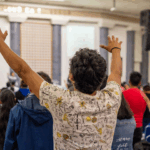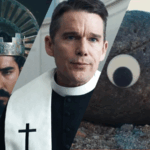As I was working at my computer I looked out the window of my study and for a moment watched construction workers on a new high rise apartment, a crane towering above them, the sun dancing through the spray of water they were directing at the newly erected Perspex balcony surrounds.
That glance set off a train of thought as I began to reflect on the place where I live and the church I belong to wondering about the similarities.
Pyrmont is not the place it used to be. Just near where I live there are steps on which the risers record something of the history of the suburb. Until the Europeans came the place was called Pirrama and was occupied by the Cadigal clans and then, over the years, it became a farm, a quarry, a place with shipyards, iron works, wool stores, factories, wharves, power stations, railway yards, pubs on every corner, swimming baths by the water and a place where workers lived. In 1891 the population was 19,000 and had not yet reached its peak. But after WWII the area began to decline with a population of 4,007 by 1961 and 1,590 by 1981. The trams stopped running in the 1950s, the rail yards closed in the 1980s to make way for the Darling Harbour development, the CSR Refinery closed in 1992 and, as a suburb, Pyrmont was described as derelict.
Today it is a great place to live close to the city. The population in 2006 was 11,312 (largely younger people with only 33 per cent born in Australia) and growing. The suburb has reinvented itself as a commercial workplace for graphic design, media, telecommunications, advertising. Cafes and restaurants outnumber the pubs which either closed or had to change their style — no longer only the drinking holes for male labourers after work but places to have a drink with your girlfriend, have dinner with your family or a group of friends from work (male and female). The railway has become a tram route, bicycles cross the suburb in ever-increasing numbers and on weekends the parks and pavement cafes are full of people with children and prams and dogs. There are memories of the history all around: warehouses converted into apartments or office blocks; street names reflecting the Aboriginal, 19th Century or industrial heritage; stone walls and parks which evoke the past and one or two derelict buildings, hangovers from the late 20th century. For the most part, that which was derelict has been renewed and brought to life.
The church in the area also experienced growth and decline — a Presbyterian Church was built in1864 but the congregation expanded so much that a new building was erected in Ultimo in the 1880s. After various uses, including being the home for the Dutch Congregation, the building by the 1990s was unusable, without a congregation and — with the suburbs it served — potentially derelict.
Today the building has been renovated. There is a fairly youthful congregation with an attendance on a Sunday morning of around 40 people of whom up to half are from a cultural heritage with a mother tongue other than English. There is another more youthful congregation of a similar size meeting on Sunday evening drawing its members from surrounding Tertiary Institutions. The building on the outside is 19th century but inside it is multipurpose with a flexibility to be used for different sorts of worship and all sorts of activities. So, with the suburb, the church too has changed.
It might be that we are sad to see the demise of the working harbour, the gentrification of a suburb such as Pyrmont, the disappearance of a lifestyle which probably wasn’t as good as it is in our imagination. But the reality is that a suburb which could never be what it was again, that was as good as dead, now has life.
Pubs, businesses, land-use, accepted norms and people have had to change to enable the community to live and, indeed, to preserve something of the history that otherwise might have disappeared completely.
As I reflected on these things I pondered whether as a Uniting Church we are in the process of reinventing ourselves for the different community that is going to grow somewhere in the future and what is necessary to preserve the tradition, the memory, the history.
Niall Reid













